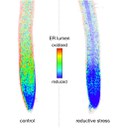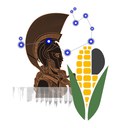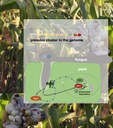
Agricultural scientist Prof. Anne-Katrin Mahlein is a pioneer in the field of sensing and imaging plant diseases.

Agricultural scientist Prof. Anne-Katrin Mahlein is a pioneer in the field of sensing and imaging plant diseases.




the robot and other technologies enable plants to be observed, analyzed, better understood and given targeted treatment. The device helps researchers to record key parameters such as plant growth, soil conditions, biodiversity and the atmosphere.

From left to right: Alexandra Becher, Brenda Mariana Huerta García, Prof. Dr. Franz Lebsanft, Anja Larissa Brüll, Prof. Dr. Matthias Becher, Kathrin Zander, Miriam Thurow, Luise Margarete Jansen, Vice Rector Prof. Dr. Birgit Ulrike Münch, Prof. Dr. Barbara Schmidt-Haberkamp, Jun.-Prof. Dr. Sarah Dietrich-Grappin.

a plant in which the researchers detected the new mechanism.

ITPK1 plays a key role in this process by generating or removing the precursor of InsP8 according to phosphate-dependent changes in ATP.

with a barley plant.

It grows strictly downwards (hypergravitropic).

It grows outwards, opening up a larger volume of soil in search for nutrients.


based on images from the Juno mission's Stellar Reference Unit camera (NASA).

from the Institute of Crop Science and Resource Conservation (INRES) at the University of Bonn.

Cyrill Stachniss (PhenoRob Cluster of Excellence) explains to Anja Karliczek how the use of robots and drones is being researched for the agricultural economy of the future.

Federal Minister Anja Karliczek met with Rector Prof. Dr. Dr. h.c. Michael Hoch (6th from right), the Rectorate and members of the six Clusters of Excellence.

of the corn smut fungus Ustilago maydis suppresses plant immune defense in maize. In reference to the "sisterly" division of tasks as effectors and the clustered occurrence in the genome, the genes were named after the Pleiades, the nymphs originating from Greek mythology and the eponymous star cluster.

The pleiades gene cluster in the Ustilago maydis (corn smut) genome encodes a family of proteins, the Pleiades, that target maize immunity. The two Pleiades Taygeta1 (Tay1) and Merope1 (Mer1) inhibit Reactive Oxygen Species (ROS) production, albeit in different cell compartments. Additionally, Mer1 acts in the nucleus to modify the activity of RFI2 homologues (Red and Far-Red Insensitive 2), a family of enzymes involved in early immune responses and that govern flowering time in plants.

Julia Klöckner presented PhytoMo coordinator Dr. Anna Kicherer and Prof. Dr. Reinhard Töpfer (Julius Kühn-Institut) with the BMEL funding notification (from right)